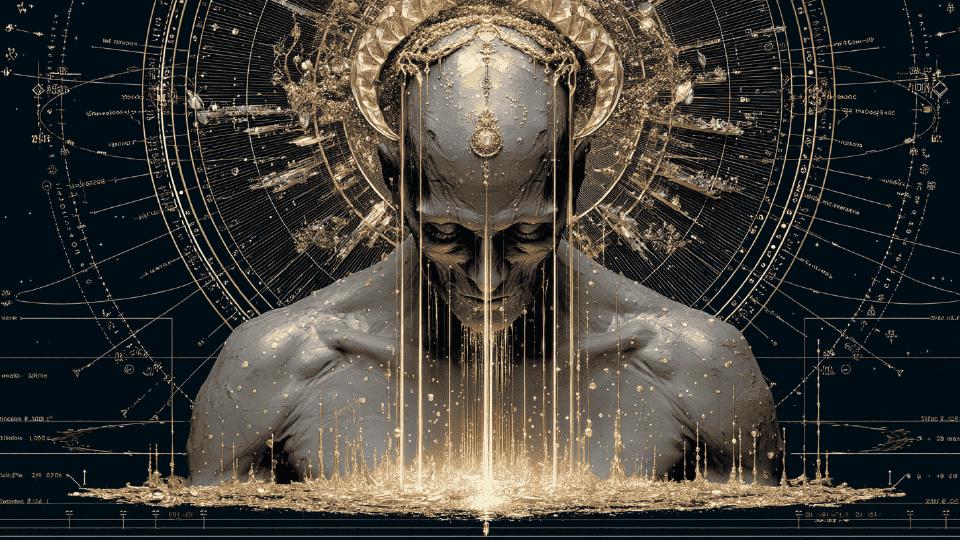
The cycle of katabasis now reaches its most paradoxical threshold. After the dissolution of residues and the absorption of the serpent force, the body stands suffused with void-light. Residual densities are cleared, yet the sense of self no longer feels confined to the physical plane. Consciousness hovers between realms, stretched between noetic vastness and dense incarnation.
State After Dissolution
With void-light permeating marrow and tissue, the body becomes radiant yet strangely light. It is no longer merely a vessel of matter but a field of translucence. This very clarity yields an ambivalent sensation: the self appears only partly embodied, existing as much beyond the frame as within it. The body may feel puppet-like when compared with the expansive void-self hovering above.
In Hermetic understanding, this reflects the interval between ascent and return. The soul, having tasted Nous, risks becoming transfixed by the upper light unless grounded once more in its earthly instrument.
Dual Existence
Here arises the condition of double awareness. On one side lies noetic vastness, boundless and free; on the other, the dense presence of incarnation, which weighs heavy in comparison. The two states remain unreconciled. One feels suspended, belonging fully to neither: not dissolved into Nous, not yet anchored in flesh.
Agrippa calls this the dual operation of spirit: one wing lifted toward contemplation, the other rooted in elemental life. Sever one wing and the whole creature falters. The Kybalion places this in the law of correspondence: the higher finds power only when reflected below.
The Temptation of Staying Above
The higher planes entice with rest and liberation. To remain there feels expansive and unbound. By contrast, re-entry into dense embodiment seems like regression into narrowness. Fear arises that incarnation may obscure the higher vision. Thus comes the temptation to remain a witness, refusing the call to inhabit.
The Corpus Hermeticum warns that souls ascending without return risk being consumed by unassimilated fire. Vision alone grants no sovereignty; only when vision descends does it gain strength. Bardon echoes this truth: ecstasy ungirded from earth soon unravels.
Necessity of Katabasis with Fire
Yet the cycle compels more. Remaining above leaves the work unfinished. Chaldean and Hermetic traditions insist that fire must not only rise but descend into mortal roots. Sovereignty demands embodiment. Without descent the self remains contemplative but inoperative. Katabasis is not regression but completion. The flame that ascended must now anchor, transforming vision into deed.
Lévi declared that astral light must be mastered in both ascent and descent, lest the operator be but a dreamer. Bardon affirmed that without drawing the Akashic influx into the body, no act of power can reach the dense world. Iamblichus held that theurgy consecrates matter itself, for divine fire must be sealed in body and rite to act.
What Entering Fully Means
To enter fully is not to fall back into confinement. It is to let void-light saturate flesh, nerves, and marrow until matter itself grows transparent to Nous. The higher self descends into matter, not as loss but as union of planes. The body becomes a conductor of Logos, remade as luminous architecture, able to bear the divine influx.
In the Hermetic Arcanum this is the fixatio of the volatile, subtle fire fixed into substance. Shaivite teaching names it the jñāna-kāya, the body of knowledge, where vastness dwells in matter without diminishment. Alchemy describes it as the coniunctio, the union of opposites. The Golden Chain of Homer renders it spirit bound with salt and sulphur, roots of renewed life.
Symbolic Context
The Chaldean Oracles declare: “The Fire must not rise alone, but also descend.” Hermetic doctrine requires that divine influx be fixed in blood and bone. Agrippa and Lévi affirmed the same: without fixation the current cannot operate in space and time. For Iamblichus, theurgy is no flight from matter but its consecration, as matter itself is vessel of divine presence. The Picatrix, too, counsels that celestial powers take effect only when impressed into earthly materia through talismanic art.
Thus across traditions the principle resounds: fire must descend, light must be fixed, spirit must embrace matter.
Experiential Tone
The tone here is ambivalence. Freedom draws upward, sovereignty calls downward. Reluctance contends with realization: reluctance at incarnation’s narrowing, realization that true power arises only through embodiment. The pressing question is not whether void-light can be received but whether it can act through flesh within dense space-time. This stage foreshadows operativity, when luminous sovereignty radiates into the world.
Here lies the pivot of the arc. It clarifies why descent is essential, even when higher states seem preferable. Embodiment is not abandonment of vision but its crown. The paradox resolves only when transcendence and incarnation are embraced together.
Principle: Every ascent must be answered by descent. Vision ungirded from body is sterile; embodiment unguided by vision is blind. The work of the adept is union of both, until the Logos shines through blood and bone.
Practice: Traditions advise practices that bind light to matter. Hermetic pore-breathing draws subtle fire into marrow. Contemplation of bones and blood as luminous framework roots Nous in form. Alchemical meditation on solve et coagula instructs that every dissolution must yield to union. Such practices steady the descent and prepare the adept to act in dense space with sovereignty rather than mere vision.